To some, cars are just a mode of transportation. A way to get from one place to another. Nothing more, nothing less. But to others, the automobiles they drive are something more. They are time capsules, holding the memories of the generations that have ridden in the backseat. They are moving sculptures, pieces of classical art from a different time. They are extensions of their owners, models of their personalities, emblematic of who they are.
Florida’s gulf coast is rife with the other kind of car owner, the type that cherishes their vehicle a little more than the typical driver. After all, it’s the perfect place for the vintage, classic, and unique car communities to exist – with year-round sunny skies, cars can live long into old age without fear of rust or deterioration. The car community, like those that come to the region, is filled with owners with diverse tastes and unique stories. Some are war veterans, who found solace in working in their garage, others are mothers, who daily drive their vintage truck for their landscaping business, and others life-long car aficionados happy to hang onto a childhood dream. The cars, like their owners run the gamut of the vintage, classic, and quirky spectrum. You’ll find iconic American Muscle from the late 1960s and ‘70s, classic British and European racing pedigree, and vintage automobiles from eras past. All of them have had their owners’ souls poured into them and have been sweated over, worked on, and painstakingly maintained for years. These are their stories.
MIKE CARRIGAN
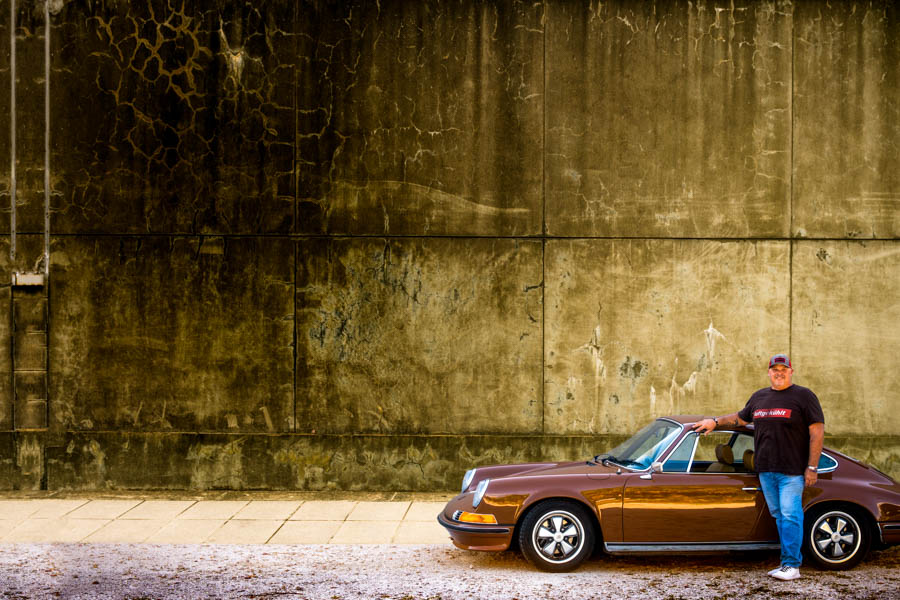
You wouldn’t think of a Porsche 911, with its sleek silhouette and heralded pedigree of German design, as a farm car. But to 7th generation Sarasotan Mike Carrigan, it is. Sort of. “My family’s an old Sarasota family. Growing up, we had land and we were able to have things like buggies and dirt bikes–on my 13th birthday, my father had a Volkswagen rail buggy built for me,” says Carrigan. “I think I was 14-years-old when I first tore down a VW engine and rebuilt it.” That foundation of working on Volkswagen engines, which share a similar design and is air-cooled like Porsche engines, paved the way for a natural transition to working on Porsches. “By the time I was in my late teens, I had my first 911 and when I was in college, I rebuilt my first Porsche engine. I guess I was addicted by then,” says Carrigan. That “addiction” is what led to Carrigan buying his sepia brown 1972 911 around ten years ago. Carrigan’s ‘72 911 is in essence, a time capsule. Aside from some routine maintenance done on the brakes and fuel line—and a high-performance engine, courtesy of the previous owner, heralded Porsche dealer Paul Sagan—the 911 is entirely original. “This car drives like a 911 would’ve driven in 1972. There hasn’t been a steering upgrade. There haven’t been brake upgrades. There haven’t been any shifter upgrades,” says Carrigan. “It’s not a car that has been kept in a bubble or restored to showroom condition—it’s a car that’s been driven and used, but has survived for 50 years in its original state.”
MOLLY SUMMERS
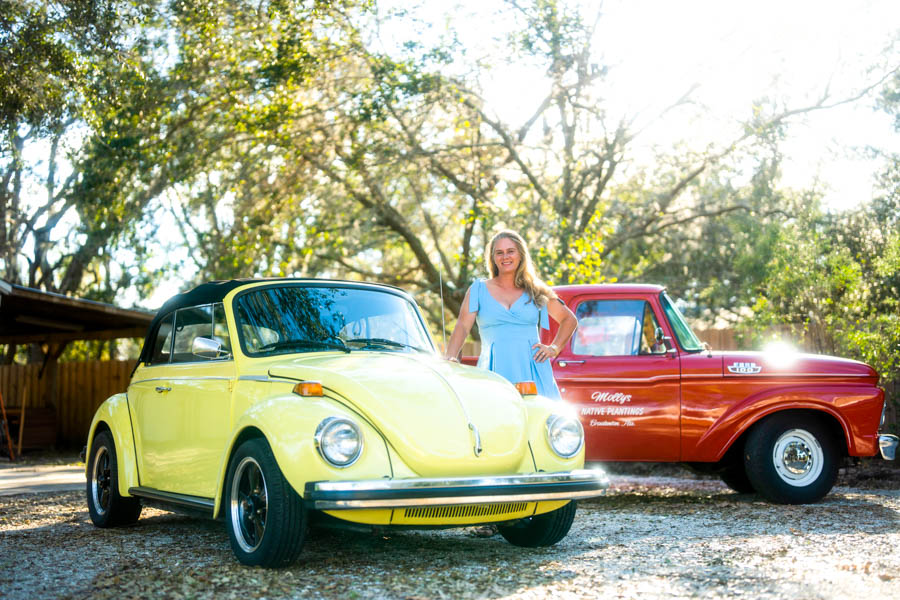
F100
“So this was a little older than what I kind of envisioned originally, but I mean, you can’t beat that old American steel. I mean, it’s just a workhorse, the engine’s great, and it’s fabulous,” says Molly Summers of her 1963 Ford F100 truck. Summers, who works as a landscape architect, purchased the truck a year ago to replace her incumbent Dodge Dakota as an everyday work truck. Although her stepside cherry red Ford is reminiscent of a different era, with its voluptuous body lines and small frame, the truck is more than capable of doing the dirty work. “I always have a chainsaw, hedge pruner, and pesticide sprayer in the bed. At first I was really worried about the paint job in the back, because I didn’t want all of my materials scratching up the paint. And then my husband Wade told me, ‘Drive it. It’s your truck. Don’t even worry about all the nicks in the paint.’ So I don’t worry about them any more,” says Summers. While most people would purchase a vintage truck as a restoration project, Summers and her husband Wade Jamison sought after the ‘63 F100 for its simplicity. The couple wanted something that they could easily work on, with an engine and transmission that were reliable and not dependent on an electrical harness and computer system like 21st century vehicles. What they got was more than just an old farm truck, but a time capsule, filled with memories both of owners past and of drivers present. “It’s really brought our family closer together. We all like going out in it and our girls like trying to drive it,” says Summers. “It’s funny how cars will do that sometimes.”
'76 VW Beetle
“I always tell people that I’ve had that car longer than I’ve had Wade,” says Molly Summers about her 1976 Volkswagen Super Beetle and her husband, Wade Jamison, respectively. “I lived for a time in England when I was young and when I came back in 1998 my dad bought it for me from a friend of his. Wade and I went on our first date in that car. We watched a meteor shower on Anna Maria Island.” Twenty-four years and two daughters later, Molly still drives her ‘76 Super Beetle, albeit not as often as she used to – her sunshine yellow VW splits time on the road with her eldest daughter and Molly’s 1963 Ford F100 truck. “From the time I got it, until we had our first daughter in 2004, I’d driven it almost into the ground. When Wade and I got serious, he started working on it. There were holes in the floor panels and you could see the road underneath you as you drove, kind of like a Flintstone car,” says Summers. While Wade’s progress on the Super Beetle was halted for some time as the couple’s young family grew – the VW was in the midst of a near total restoration, from the engine and transmission, to the upholstery inside the car, to a new paint job and body work, which Wade did himself – Molly still found plenty of time to drive it over the past 18 years, whether as a second car for her landscaping business or a convertible catalyst for some fun in the sun. “People on the road always tell me, ‘Oh, my first car was a Beetle. It brings back such great memories.’ And it brings back a lot of fun memories for me as well, of being in my early 20s, just feeling the wind in my hair and driving around without a care in the world,” says Summers.
NICK VINOGRADOV
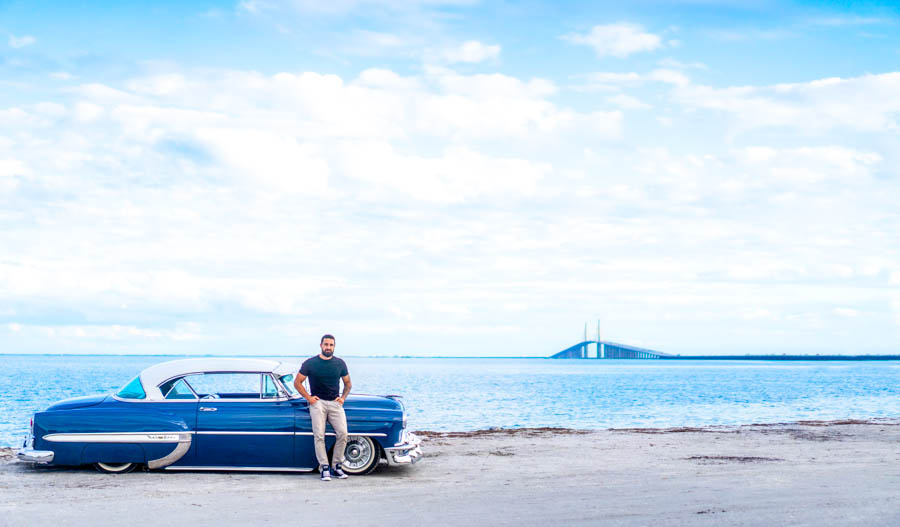
“When I graduated from high school, I joined the military. I got blown up while serving in Iraq and received a Purple Heart, but after I got out I had a lot of PTSD. After that, working on cars and being in my garage became my happy place,” says Nick Vinogradov. Over the years, Vinogradov’s “happy place” has produced more than its fair share of good memories, starting with his first car, a 1979 Chevrolet Camaro to his current 1953 Chevrolet Bel Air. “Putting together cars is my passion. Just the feeling of building your own car from the ground up and then being able to drive it, there’s nothing else like that in the world,” says Vinogradov. “My dream car was a ‘53 or ‘54 Bel Air, hard top, with a LS swap (replacing the stock engine with one from General Motors heralded LS line) and full air ride suspension. I’d built a ‘53 Bel Air before, but I didn’t do air ride and a lot of other stuff to it. With this car,
I told myself ‘All right, I’m going to put everything else aside and accomplish everything that I want to with this build.’”
What ensued was a two-year build, from the time Vinogradov purchased the Bel Air to its first cruise, all done by Vinogradov alone in his three-car garage. No lift. No custom tools. And no help. Just some of the challenges of the build included swapping out the stock engine for an LS3 engine out of a wrecked 2014 Camaro, installing wiring harnesses for the engine and the electrical components of the car, and installing air ride suspension. “It’s almost like a modern car in an old body. The major challenges were getting everything to fit and work right correctly. I’m doing everything by hand with 2 x 4s, and just trying to figure out how to manipulate everything in the space that I have,” says Vinogradov.
BILL LESSIG
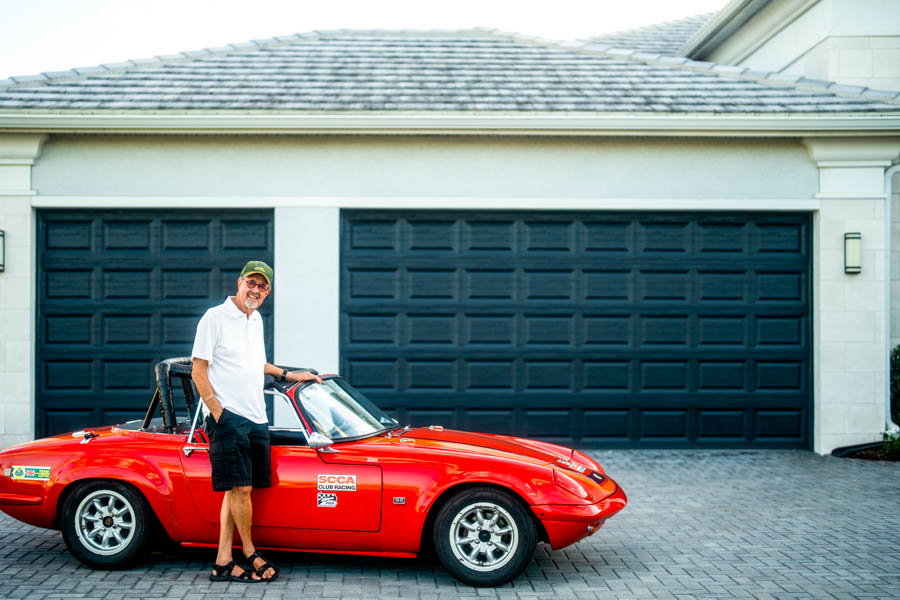
“I grew up around Reading, Pennsylvania and I was familiar with the Duryea hill climb, which they race up a windy switch back road up to the top of Mount Penn. As a child, I used to go watch it – it was always something that I’d wanted to do,” says Bill Lessig, owner of a 1967 Lotus Elan. It was through his Lotus, in 1969, that Lessinger was able to fulfill his childhood dream of hill climbing through the Pennsylvania mountains. “My first hill climb was in Hershey, Pennsylvania in 1969. I had taken some tires with me in the passenger seat and really enjoyed the opportunity to drive the car fast, the way it was meant to be driven, on an interesting road,” says Lessig. “That got me hooked into hill climbing, so I hill-climbed the car almost every year from then up until 2019, basically 50 years.”
Over the years, Lessig’s relationship with his Lotus grew as he became more and more involved in hill climbing. While the car had a great foundation for aggressive driving, with a lightweight chassis capable of making tight turns at breakneck speeds, it had to be modified to be able to compete with the other cars in its class. “Building the car out was very much a learning process. I’m a mechanical engineer, but had nothing to do with cars in my career,” says Lessig. “As I gradually learned more and more about working on the engine, I got braver and braver about taking things apart. And finally I tore down the whole engine and installed racing camshafts in it and higher compression pistons – modified the engine to give it more horsepower. Then I changed the suspension to a racing set up. Lastly, I took weight out of the car—I took the side windows and the windshield off of it. I ended up with a Lotus that was a fair amount lighter and more powerful than the stock car and that’s when I started winning some of my classes.”
JEFF DAVIS
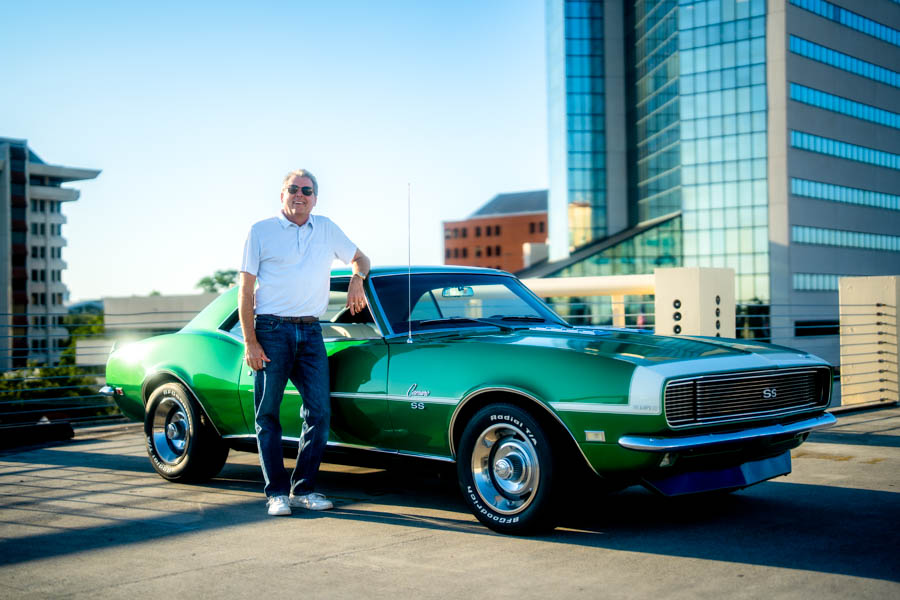
“There are people that can go to an art gallery, look at a painting and see artwork. Then there are other people, like myself, that just see a picture. But when I look at my car, I see artwork,” says Jeff Davis of his 1968 Chevrolet Camaro. If the muscle car, which Davis purchased in 2002, is akin to a moving sculpture, it’s one that took years to perfect. After all, Davis’ ‘68 Camaro wasn’t just another hot rod that he was looking to build out and modify, it was a time capsule, still maintaining all of the original parts and components that it had when it rolled out of the dealership in California back in 1968. “I’ve had eight or 10 muscle cars and you usually get them after a number of other people have put their DNA in it. Whether you like it or not, you live with whatever other people did to it,” says Davis. “This car was all original. It had the original seats in it, with the springs worn through the seat, and a pillow to sit on so you wouldn’t poke your butt with the springs. The headliner was hanging down, tied together with a fishing line. It was a
beautiful thing to find an unmolested car with a blank canvas to start with.”
Over the next seven years, Davis went to work on the restoration, all the while making sure to keep everything to the original specifications. First came the suspension and drivetrain, then a complete overhaul of the interior, followed by a rebuilding of the Camaro’s 5.7 liter small-block V-8 engine, and finally a complete repainting of the car that took it from black to the factory original “rally metallic green”. Along the way, Davis had some help, from his brother-in-law who specialized in body work to the team at Competition Motorsports that assisted with the engine overhaul. “It’s the nicest car I’ve ever owned out of dozens of cars over my lifetime. It was a collaborative effort of half a dozen people in my life that stepped up to help me get this car the way it is now,” says Davis.
DANIEL SLOTTKE
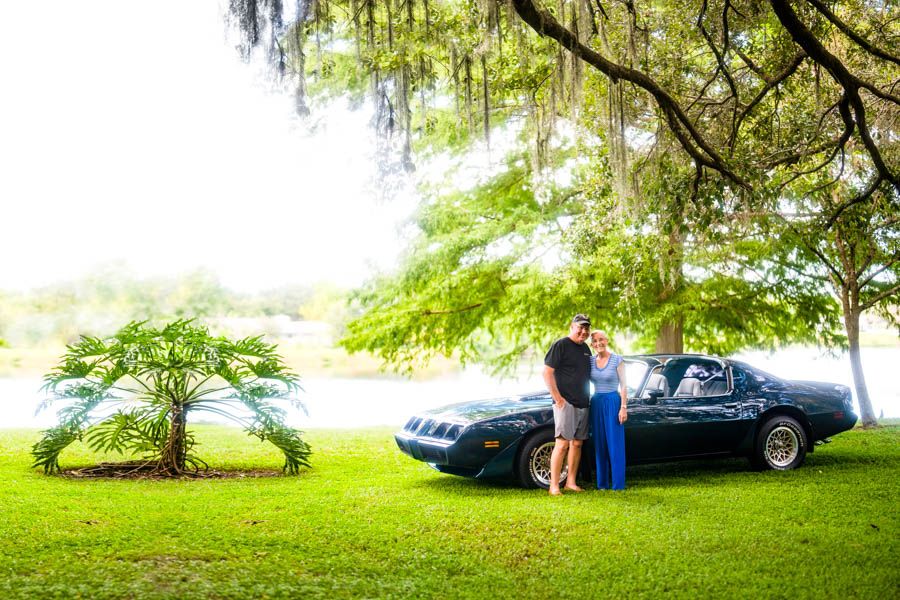
“My wife says every time I get in that car, I’m like a different person,” says Daniel Slottke of his 1979 Pontiac Trans Am. “I was 23 years old when I bought that car and I’m 67 now. It still makes me feel like that 20-year-old when I get in it.” For Slottke, his ‘79 Trans Am isn’t just a car, it’s a part of who he is. While it’s rare to find a ‘79 Trans Am in as good of a condition as Slottke’s, it’s even rarer to find one that has belonged to the original owner ever since it was purchased. However, the cost of maintaining an original vehicle for all of this time, hasn’t come without its challenges. The most notable of which came in 1985, after a van smashed into the rear bumper of the Trans Am. Slottke, who at the time had just moved from Wisconsin down to Sarasota, had his car partially repainted in Wisconsin, before finishing it in Florida. No big deal, right? Wrong. In Wisconsin, the painter had used the wrong paint, a lacquer-based paint instead of a heavy-duty urethane paint. The result was disastrous. “I was told by the painter in Florida that the car had too much paint on it and was basically ruined. He told me, “If you want to keep it the car’s going to have to be stripped—all the paint has to be taken off right to the bare metal,’” says Slottke. “He made me a deal—I could use his shop and all of his tools, but I had to do all the work.” Slottke, who was in-between jobs at the time, spent six days a week for three months straight taking his Trans Am apart piece by piece and stripping the paint by hand, before beginning the painstaking process of painting the car. “It was my first time and it was my last time ever doing a paint job. By the time I was done with the car, I got home and put the cover over it. I don’t think I looked at it for almost six months because I was so tired of working on it,” says Slottke. The result, however, was well worth the wait.








